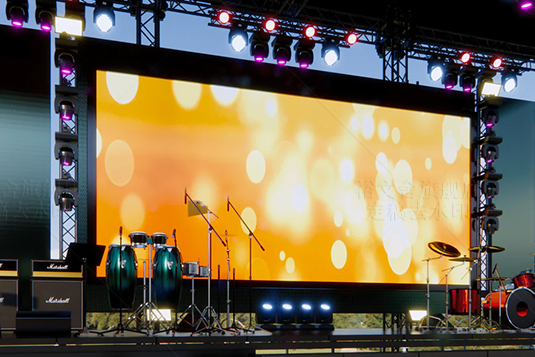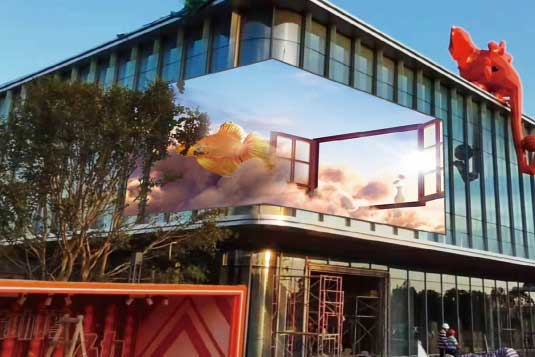The Tech Behind the Magic: Demystifying LED Volume Specifications for Virtual Production
Abstract:
Virtual production stages powered by massive LED walls are revolutionizing filmmaking and broadcast. But what makes these “volumes” tick? This blog dives deep into the critical technical specifications of LED panels used for virtual backgrounds – resolution, pixel pitch, refresh rate, color accuracy, and more. Understand how each parameter impacts image quality, camera compatibility, and the final on-screen result, empowering informed decisions for broadcasters and production teams.
(Image 1: A camera crew filming against a vast, curved LED wall displaying a photorealistic cityscape. A presenter stands in the foreground.)
图 1: 摄像团队在展示逼真城市景观的巨大曲面 LED 墙前拍摄。主持人在前景中站立。(Illustrates the core application: filming talent against the LED background)
The shimmering cityscape behind the news anchor, the fantastical alien planet enveloping the actors – these are no longer confined to green screens and lengthy post-production. LED volumes, giant walls and ceilings constructed from specialized LED panels, are bringing virtual backgrounds to life in real-time, transforming television production. But the magic relies heavily on the underlying technology. Choosing the right LED panels is paramount. Let’s dissect the key technical specifications that define a high-performance virtual production volume:
1. Pixel Pitch (P): The Foundation of Detail
-
What it is: The distance (in millimeters) between the centers of two adjacent pixels (e.g., P1.2, P1.5, P1.8, P2.6). -
Why it matters: This is arguably the most critical spec for camera work. -
Resolution & Detail: Smaller pitch = more pixels per square meter = finer detail and smoother images, especially crucial for close-up shots. -
Minimum Viewing/Camera Distance: Smaller pitch allows cameras to get physically closer to the wall without seeing individual pixels or the “screen door effect.” Rule of thumb: Minimum camera distance (meters) ≈ Pixel Pitch (mm) * 1000 / (Lens Focal Length (mm) * Camera Sensor Pixel Size (µm)). P1.2-P2.6 are common ranges for volumes.
-
-
Trade-off: Smaller pitch panels are significantly more expensive and generate more heat per unit area.
(Image 2: Close-up diagram comparing two LED panels: one with large pixel pitch (clearly visible dots/grid) and one with small pixel pitch (appearing smooth).)
图 2: 特写对比图:左侧为大像素间距 LED 面板(清晰可见点状/网格),右侧为小像素间距面板(呈现平滑效果)。(Visually explains the impact of pixel pitch on perceived image smoothness)
2. Resolution & Viewing Area: Building the Canvas
-
What it is: The total number of pixels (Width x Height) across the entire LED wall. Determined by panel resolution (e.g., 1920×1080 modules) and the total number of modules used. -
Why it matters: -
Immersive FOV: Higher resolution creates a larger, more seamless canvas, essential for wide shots and immersive environments. -
Camera Framing Flexibility: Provides more “background real estate” for camera moves without seeing the edges. -
Content Detail: Matches the detail level of high-resolution virtual backgrounds. Broadcast volumes often start at 4K total resolution, with many pushing to 8K or beyond.
-
3. Refresh Rate & Frame Rate: Eliminating Artifacts
-
Refresh Rate (Hz): How many times per second the LED panel redraws the entire image (e.g., 3840Hz, 7680Hz). -
Frame Rate (fps): The rate at which the content source (e.g., render engine) outputs new frames (e.g., 24, 25, 30, 50, 60 fps). -
Why it matters (Crucial for Cameras!): -
Scan Lines/Rolling Shutter Artifacts: If the LED refresh rate isn’t significantly higher than the camera’s shutter speed/settings, dark horizontal bands (scan lines) or distortion will appear in the footage. High refresh rates (typically 3840Hz or higher) are essential for clean camera capture, especially with fast motion or panning shots. -
Flicker: Insufficient refresh rates can cause visible flicker on camera.
-
4. Bit Depth & Color Fidelity: Achieving Realism
-
Bit Depth: The number of bits used to represent the color intensity per channel (Red, Green, Blue). Common: 14-bit, 16-bit processing. -
Color Gamut: The range of colors the panel can display (e.g., ≥ 95% DCI-P3, Rec. 2020). -
Why it matters: -
Smooth Gradients: Higher bit depth (16-bit processing is ideal) prevents visible banding (contouring) in subtle gradients like skies and skin tones. -
Color Accuracy: Wide color gamut ensures virtual backgrounds match the intended artistic look and integrate seamlessly with physical props/talent. Broadcast often targets Rec. 709 or DCI-P3. -
HDR Compatibility: Requires wide gamut, high brightness, and high contrast.
-
(Image 3: Side-by-side images showing banding artifacts (bad) vs. a perfectly smooth gradient (good) on an LED background, representing low vs. high bit depth.)
图 3: 并排图像展示 LED 背景上的色带伪影(差)与完美平滑渐变(好),代表低比特深度与高比特深度的效果。(Highlights the importance of high bit depth for image quality)
5. Brightness (Nits) & Contrast Ratio: Matching Reality
-
Brightness (cd/m² or Nits): The maximum light output of the panel (e.g., 800 nits, 1500 nits, 3000+ nits). -
Contrast Ratio: The ratio between the brightest white and the darkest black the panel can display simultaneously (e.g., 5000:1, 10000:1). -
Why it matters: -
Studio Lighting Integration: The LED wall must be bright enough to convincingly act as a light source on talent/sets and compete with studio lights. Typical broadcast volumes require 800-1500+ nits. -
HDR: High brightness and high contrast are fundamental for High Dynamic Range content. -
Black Levels: High contrast ratio delivers deeper blacks, crucial for realism and preventing the background from looking washed out.
-
6. Color Calibration & Uniformity: Consistency is Key
-
What it is: The process of ensuring every panel/module across the entire volume displays colors and brightness identically. -
Why it matters: -
Seamlessness: Critical for creating a believable, uninterrupted background image. Any color or brightness shift between panels instantly breaks the illusion. -
Camera Matching: Ensures consistent color reproduction across all camera angles and shots. -
Maintenance: Requires sophisticated calibration systems and ongoing monitoring/adjustment.
-
7. Viewing Angle: Maintaining Fidelity Off-Axis
-
What it is: The angle at which the display can be viewed without significant color shift or brightness loss (e.g., 160° H / 160° V). -
Why it matters: -
Camera Angles: Cameras (and sometimes talent) will view the screen from off-center angles. Wide viewing angles ensure consistent color and brightness regardless of the camera position. -
Talent Perspective: Helps actors see a consistent environment.
-
8. Cabinet Design & Seamlessness: Building the Wall
-
Cabinet Size & Weight: Impacts installation speed, flexibility (e.g., curved configurations), and stage floor loading. -
Seam Width: The physical gap between adjacent LED modules/cabinets. Narrower seams (e.g., <1mm) are less visible to cameras, especially on curved walls or at shallow angles. -
Curvature: Panels designed for tighter radii enable more immersive curved volumes.
(Image 4: A close-up photo of the corner of two LED cabinets mounted together, highlighting the very narrow physical gap (seam) between them.)
图 4: 两个 LED 箱体安装在一起的角落特写照片,突出显示它们之间极窄的物理间隙(接缝)。(Focuses on the critical aspect of minimizing visible seams)
9. Control System & Processing Power: The Brain
-
Sending Cards: Interface between the video source (render PCs) and the LED panels. Must handle high bandwidth (resolution, refresh rate, bit depth). Redundancy is critical for broadcast. -
Receiving Cards: Mounted on the LED cabinets, receive data from sending cards and drive the LEDs. -
Processing: Needs powerful hardware to handle complex video processing, color management, calibration, and potentially real-time warp & blend for curved surfaces or projector blends. -
Software: Robust control software for setup, monitoring, calibration, and troubleshooting is essential.
Conclusion: Balancing the Equation
Selecting LED panels for a broadcast virtual volume isn’t about chasing the single highest spec in every category. It’s about understanding the trade-offs (cost, heat, power, weight) and finding the optimal balance for the specific production needs, budget, and camera requirements. Prioritize the specs most critical for camera capture: high refresh rate, sufficient brightness, excellent color uniformity/calibration, and an appropriate pixel pitch for the intended camera distances. By mastering these technical parameters, broadcasters and production teams can harness the transformative power of virtual production, creating stunning, believable environments that captivate audiences live.
Key Specifications Summary Table:
| Feature | Description | Importance for Broadcast VP | Typical Range/Value |
|---|---|---|---|
| Pixel Pitch (P) | Distance between pixels (mm) | CRITICAL Defines detail & min. camera distance | P1.2 – P2.6 |
| Resolution | Total pixels (W x H) of the entire wall | Determines canvas size & detail level | 4K (3840×2160) to 8K+ |
| Refresh Rate | How fast the panel redraws the image (Hz) | CRITICAL Eliminates camera scan lines | ≥ 3840 Hz (Higher is better) |
| Bit Depth | Bits per color channel (processing) | Prevents banding in gradients | 14-bit, 16-bit (Ideal) |
| Color Gamut | Range of displayable colors | Accuracy for realistic backgrounds | ≥ 95% DCI-P3 / Rec. 709 |
| Brightness | Maximum light output (Nits or cd/m²) | Matches studio lighting, prevents washout | 800 – 1500+ Nits (Broadcast) |
| Contrast Ratio | Brightest white vs. darkest black | Deeper blacks, improved realism | 5000:1 to 10000:1+ |
| Calibration/Uniformity | Color/brightness consistency across all panels | CRITICAL Seamless image, no patches | Requires dedicated systems/process |
| Viewing Angle | Angle without color/brightness loss (H/V) | Consistent look from different angles | ≥ 160° / 160° |
| Seam Width | Physical gap between cabinets/modules | Minimizes visibility to cameras | < 1mm (Narrower is better) |



-800x600.jpeg)